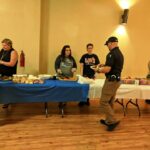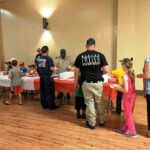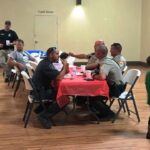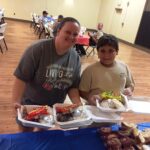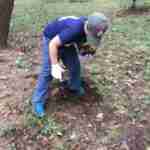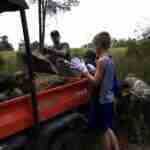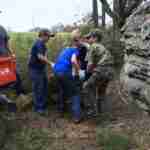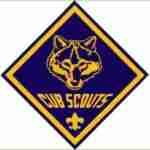
The #247 Scout Expo is coming up this Saturday at the Babe Ruth Field in Centre – and it’ll feature an array of activities for those interested in learning about the scouting program.
WEIS Radio recently spoke with Scout Master Adam Blaylock about that event:

Blaylock says Pack #247 currently has eleven members – and he’d certainly like to see that number grow and that’s why they’re putting on the Expo this weekend, as a way of showing kids and parents alike how much fun, and how educational, scouting can be:

Since re-forming around a year and a half ago, Pack #247 has been extremely active in their community, conducting several service projects. On July 21st they hosted a First Responder Dinner at the First United Methodist Church on Main Street in Centre – they’ve volunteered to help cleanup local parks and have helped with a number of cleanup projects at Cherokee Rock Village, and they have also worked hand-in-hand with Centre Mayor Tony Wilkie on a variety of community service projects.

Since 1930, the Boy Scouts of America has helped younger boys through Cub Scouting. It is a year-round family program designed for boys who are in the first grade through fifth grade (or 7, 8, 9, and 10 years of age).
Parents, leaders, and organizations work together to achieve the purposes of Cub Scouting. Currently, Cub Scouting is the largest of the BSA’s three membership divisions. (The others are Boy Scouting and Venturing.)
Membership
Cub Scouting members join a Cub Scout pack and are assigned to a den, usually a neighborhood group of six to eight youth. Lion Cubs (kindergarteners), Tiger Cubs (first-graders), Wolf Cub Scouts (second graders), Bear Cub Scouts (third graders), and Webelos Scouts (fourth and fifth graders) meet weekly.
Once a month, all of the dens and family members gather for a pack meeting under the direction of a Cubmaster and pack committee. The committee includes parents of youth in the pack and members of the chartered organization.
Volunteer Leadership
Thousands of volunteer leaders, both men and women, are involved in the Cub Scout program. They serve in a variety of positions, as everything from unit leaders to pack committee chairmen, committee members, den leaders, and chartered organization representatives. Parents are strongly encourage to get involved with their pack in some capacity.
Like other phases of the Scouting program, a Cub Scout pack belongs to an organization with interests similar to those of the BSA. This organization, which might be a church, school, community organization, or group of interested citizens, is chartered by the BSA to use the Scouting program. This chartered organization provides a suitable meeting place, adult leadership, supervision, and opportunities for a healthy Scouting life for the youth under its care. Each organization appoints one of its members as a chartered organization representative.
Advancement Plan
Recognition is important to young people. The Cub Scout advancement plan provides fun for the youth, gives them a sense of personal achievement as they earn badges, and strengthens family understanding as adult family members work with youth on advancement projects.
Lion Cubs
The Lion Program is for kindergarten-aged youth and their adult partner to be introduced into the Cub Scout Program together. A group of six to eight youth and their adult partners will meet together as a den and will be mentored by a Lion Guide
Tiger Cub
The Tiger Cub program is for first grade (or age 7) youth and their adult partners. There are five Tiger Cub achievement areas. The Tiger Cub, working with their adult partner, completes 15 requirements within these areas to earn the Tiger Cub Badge. These requirements consist of an exciting series of indoor and outdoor activities just right for youth in the first grade.
Bobcat
The Bobcat rank is for all youth who join Cub Scouting.
Wolf
The Wolf program is for youth who have completed first grade (or are age 8). To earn the Wolf badge, a Cub Scout must pass twelve achievements involving simple physical and mental skills.
Bear
The Bear rank is for youth who have completed second grade (or are age 9). There are 24 Bear achievements in four categories. The Cub Scout must complete 12 of these to earn the Bear badge. These requirements are somewhat more difficult and challenging than those for Wolf rank.
Webelos
This program is for youth who have completed third grade (or are age 10). A Scout may begin working on the Webelos badge as soon as he or she joins a Webelos den. This is the first step in their transition from the Webelos den to the Scouts BSA troop. As they complete the requirements found in the Webelos Scout Book, they will work on activity badges, attend meetings led by adults, and become familiar with the Scouts BSA requirements—all leading to the Arrow of Light Award.
Activities
Cub Scouting means “doing.” Everything in Cub Scouting is designed to have the youth doing things. Activities are used to achieve the aims of Scouting—citizenship training, character development, and personal fitness.
Many of the activities happen right in the den and pack. The most important are the weekly den meetings and the monthly pack meetings.
Cub Scout Academics and Sports
The Cub Scout Academics and Sports program provides the opportunity for youth to learn new techniques, increase scholarship skills, develop sportsmanship, and have fun. Participation in the program allows youth to be recognized for physical fitness and talent-building activities.
Camping
Age-appropriate camping programs are packed with theme-oriented action that brings Lions Cubs, Tiger Cubs, Cub Scouts, and Webelos Scouts into the world of imagination. Day camping comes to the boy in neighborhoods across the country; resident camping is at least a three-day experience in which Cub Scouts and Webelos Scouts camp within a developed theme of adventure and excitement. “Cub Scout Worlds” are used by many councils to carry the world of imagination into reality with actual theme structures of castles, forts, ships, etc. Cub Scout pack members enjoy camping in local council camps and other council-approved campsites. Camping programs combine fun and excitement with doing one’s best, getting along with others, and developing an appreciation for ecology and the world of the outdoors.
Cub Scouting Ideals
Apart from the fun and excitement of Cub Scout activities, the Cub Scout Promise, the Law of the Pack, the Tiger Cub motto, and the Cub Scout sign, handshake, motto, and salute all teach good citizenship and contribute to a boy’s sense of belonging.
Scout Oath
On my honor, I will do my best, to do my duty, to God and my country and to obey the Scout Law; To help ther people at all times; To keep myself physically strong, mentally, awake, and morally straight.
Scout Law
A Scout is trustworthy, loyal, helpful, friendly, courteous, kind, obedient, cheerful, thrifty, brave, clean, and reverent.
Colors
The Cub Scout colors are blue and gold. They have special meaning, which will help boys see beyond the fun of Cub Scouting to its ultimate goals.
The blue stands for truth and spirituality, steadfast loyalty, and the sky above. The gold stands for warm sunlight, good cheer, and happiness.


